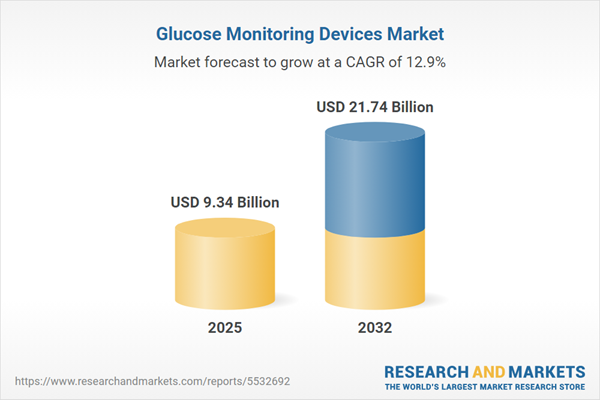Speak directly to the analyst to clarify any post sales queries you may have.
The glucose monitoring devices market is evolving rapidly as the demand for advanced diabetes management solutions grows. Senior decision-makers require precise insights into changing technologies, regulation, and competitive dynamics shaping this critical medical devices sector.
Market Snapshot: Glucose Monitoring Devices Market Growth and Outlook
The Glucose Monitoring Devices Market grew from USD 8.26 billion in 2024 to USD 9.34 billion in 2025. It is expected to continue growing at a CAGR of 12.85%, reaching USD 21.74 billion by 2032. This segment benefits from relentless innovation, surging global diabetes prevalence, and digital transformation in healthcare improving both usability and clinical outcomes. Strategic adaptation is required across manufacturers, suppliers, and care networks as demand shifts from conventional fingerstick devices toward continuous and non-invasive systems.
Scope & Segmentation
- Device Types: Continuous glucose monitoring (personal and professional), flash glucose monitoring, self-monitoring of blood glucose.
- Technologies: Invasive (colorimetric, electrochemical amperometric), minimally invasive (subcutaneous sensors), non-invasive (optical spectroscopy, transdermal extraction).
- Applications: Gestational diabetes, type 1 diabetes, type 2 diabetes.
- End Users: Ambulatory care, home care, private hospitals, public hospitals.
- Distribution Channels: Hospital pharmacies, online stores (company websites, e-commerce platforms), retail pharmacies (chain, independent).
- Geographic Regions: Americas (including United States, Canada, Mexico, Brazil, Argentina, Chile, Colombia, Peru), Europe, Middle East and Africa (UK, Germany, France, Russia, Italy, Spain, Netherlands, Sweden, Poland, Switzerland, UAE, Saudi Arabia, Qatar, Turkey, Israel, South Africa, Nigeria, Egypt, Kenya), Asia-Pacific (China, India, Japan, Australia, South Korea, Indonesia, Thailand, Malaysia, Singapore, Taiwan).
- Key Companies: Abbott Laboratories, Dexcom, Inc., Medtronic plc, F. Hoffmann-La Roche AG, Johnson & Johnson, Ascensia Diabetes Care Holdings AG, Senseonics Holdings, Inc., ARKRAY, Inc., Nipro Corporation, Sinocare, Inc.
Key Takeaways
- Continuous innovation, from higher sensor accuracy to expanded data integration, is accelerating the deployment of advanced patient-centric systems.
- Emerging digital health strategies allow seamless integration of glucose data with telehealth platforms, optimizing disease management and supporting real-time remote interventions.
- Regulatory agencies are increasingly aligning approval pathways with rapid tech advancement, enabling quicker commercialization of new monitoring technologies.
- Competitive dynamics are shifting. Agile start-ups and established device manufacturers that embrace open data standards and collaborative models are driving change in diabetes care.
- Segment diversification—from gestational and pediatric to adult diabetes management—necessitates tailored solutions for distinct user populations, healthcare settings, and care pathways.
- Strategic partnerships, particularly those bridging medical device, pharmaceutical, and digital health ecosystems, are fostering holistic monitoring and disease management platforms.
Tariff Impact on Supply Chain Dynamics
Recent tariff policies in the United States have prompted considerable shifts in sourcing, supplier networks, and manufacturing locations for glucose monitoring device components. Manufacturers are investing in domestic production, diversifying their supplier bases, and recalibrating pricing strategies to balance affordability and resilience. Service providers and distributors are renegotiating contracts, with the overall supply chain increasingly focused on transparency, agility, and risk mitigation.
Research Methodology & Data Sources
This report uses a robust combination of primary interviews with endocrinologists, diabetes educators, procurement experts, and technology specialists, as well as secondary research from peer-reviewed journals, regulatory filings, and healthcare associations. Analytical frameworks such as SWOT analysis, five forces evaluation, and value chain mapping ensure reliable, actionable insights for market participants.
Why This Report Matters
- Offers actionable intelligence for C-level leaders seeking to align product portfolios, supply strategies, and partnership models with evolving market opportunities.
- Equips stakeholders with clear visibility on regional dynamics, regulatory environments, and shifting patient preferences, supporting informed go-to-market decisions.
Conclusion
The glucose monitoring devices sector is defined by rapid evolution in patient needs, technology adoption, and policy change. Stakeholders who recognize these dynamics and act strategically can secure meaningful leadership in the diabetes care ecosystem.
Additional Product Information:
- Purchase of this report includes 1 year online access with quarterly updates.
- This report can be updated on request. Please contact our Customer Experience team using the Ask a Question widget on our website.
Table of Contents
3. Executive Summary
4. Market Overview
7. Cumulative Impact of Artificial Intelligence 2025
Companies Mentioned
The companies profiled in this Glucose Monitoring Devices market report include:- Abbott Laboratories
- Dexcom, Inc.
- Medtronic plc
- F. Hoffmann-La Roche AG
- Johnson & Johnson
- Ascensia Diabetes Care Holdings AG
- Senseonics Holdings, Inc.
- ARKRAY, Inc.
- Nipro Corporation
- Sinocare, Inc.
Table Information
| Report Attribute | Details |
|---|---|
| No. of Pages | 182 |
| Published | November 2025 |
| Forecast Period | 2025 - 2032 |
| Estimated Market Value ( USD | $ 9.34 Billion |
| Forecasted Market Value ( USD | $ 21.74 Billion |
| Compound Annual Growth Rate | 12.8% |
| Regions Covered | Global |
| No. of Companies Mentioned | 11 |









